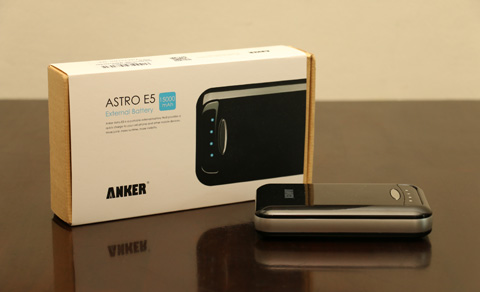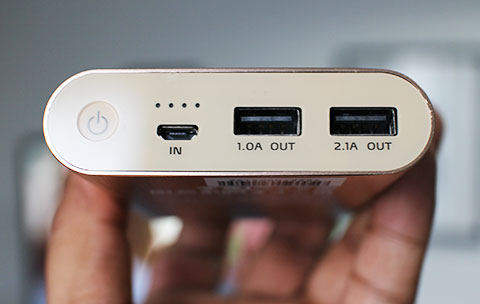Most people buy powerbanks based on indicated charging capacities. However, there are some details that we need to understand in order to maximize the use of these rechargeable batteries.

Powerbanks have become a huge secondary market commodity following the popularity of smartphones and tablets. It’s not a huge business that a lot of brands are coming out left and right.
In this quick guide, we explain why not all powerbanks are created equal.
1) Re-Charge Cycles and Lifespan. Powerbanks, like any other rechargeable batteries have a recommended recharge cycle. A good powerbank will have somewhere around 500 recharge cycles while sub-standard ones will have around 300 cycles only.

If you recharge your powerbank once a day, that means the lifespan can be somewhere between 300 days to 500 days. Once this re-charge cycle is fully consumed, the powerbank will no longer be able to re-charge to its usual capacity and degrades to about 50-70%.
2) Power Storage Capacity. Powerbanks cannot store 100% of the full power capacity that it states it can. Good ones can give you between 70 to 80%. Great ones like Anker powerbanks can go as much as 85-90%. That means if your typical powerbank says it can do 10,000mAh, the actual capacity could just be 7,000mAh.

This is called discharge efficiency and what is wasted or lost in the process is due to the internal circuitry of the powerbank as well as how good/efficient the batteries inside are.
3) Double A Batteries (cylindrical lithium-ion rechargeable). Most powerbanks use a 65mm AA-like re-chargeable batteries (18650, cylindrical lithium-ion rechargeable) connected in a series. These are easier to source, manufacture and assemble. That’s the reason why a lot of powerbanks have similar but odd-numbered capacities like 5,200mAh or 10,400mAh.

This is because they use multiple re-chargeable batteries (multiples of 2200mAh to 3400mAh) and not just one single large Li-Ion block. Some powerbanks which have thinner profiles do use a specific rectangular-shaped batteries like in smartphones.
4) Output Voltage and Output Current. The symbol mAh does not mean milliamps as most of us refer to but is actually milli ampere-hour and means measure of electric charge. One the other hand, Watt Hour (Wh) is a measure of electric energy.
The relationship of the two is shown in this formula:

milliamp-hour = watt-hour × 1000 / V
or
mAh = Wh × 1000 / V
The typical voltage for Li-Ion in powerbanks is 3.7V but output can go up to 5V. This is the reason why we see either of the two numbers in smartphones, laptops, or powerbanks.

The output current is measured in ampere which states how fast the current is passed thru the device. Most smartphones will use 1A while bigger tablets like the iPad might need 2.1A. Powerbanks have different ports for 1A and 2.1A while a fewer ones like Anker have intelligent sensing ports that auto adjusts the current depending on what the device needs.

Some phones like the Oppo Find 7 can handle up to 4A of current without damaging its internal battery.
5) Charging Cables. Charging cables are not created equal. Most cables have a data wire and a charging wire within the cable itself.
Typical charging cables are in the 28/28 gauge range with a wire diameter of about 0.321mm (first number represents the gauge of the data wire and the second number represents the charging wire). This is the reason why some cables could not charge phones or indicate slow charging.

We suggest getting a 28/24 gauge cable which are thicker. The 24 gauge ones are about 60% larger in diameter (0.511mm) and can handle 2amps of current. Of course, the cables can only transmit the same amount of power as the powerbank or power charger supplying it.
We also suggest to not attach the cable to the powerbank when it is not in use, especially in storage. It can still be feeding a small amount of current that can slowly discharge the powerbank.
{source}

YugaTech.com is the largest and longest-running technology site in the Philippines. Originally established in October 2002, the site was transformed into a full-fledged technology platform in 2005.
How to transfer, withdraw money from PayPal to GCash
Prices of Starlink satellite in the Philippines
Install Google GBox to Huawei smartphones
Pag-IBIG MP2 online application
How to check PhilHealth contributions online
How to find your SIM card serial number
Globe, PLDT, Converge, Sky: Unli fiber internet plans compared
10 biggest games in the Google Play Store
LTO periodic medical exam for 10-year licenses
Netflix codes to unlock hidden TV shows, movies
Apple, Asus, Cherry Mobile, Huawei, LG, Nokia, Oppo, Samsung, Sony, Vivo, Xiaomi, Lenovo, Infinix Mobile, Pocophone, Honor, iPhone, OnePlus, Tecno, Realme, HTC, Gionee, Kata, IQ00, Redmi, Razer, CloudFone, Motorola, Panasonic, TCL, Wiko
Best Android smartphones between PHP 20,000 - 25,000
Smartphones under PHP 10,000 in the Philippines
Smartphones under PHP 12K Philippines
Best smartphones for kids under PHP 7,000
Smartphones under PHP 15,000 in the Philippines
Best Android smartphones between PHP 15,000 - 20,000
Smartphones under PHP 20,000 in the Philippines
Most affordable 5G phones in the Philippines under PHP 20K
5G smartphones in the Philippines under PHP 16K
Smartphone pricelist Philippines 2024
Smartphone pricelist Philippines 2023
Smartphone pricelist Philippines 2022
Smartphone pricelist Philippines 2021
Smartphone pricelist Philippines 2020
Jed Buenaventura says:
Correction for #3.
Powerbanks don’t use “AA”. They use the battery cells found on laptop battery packs namely “16850”.
Thanks :)
v says:
correct. The article should be re worded. An 18650 doesnt look like an AA battery, an 18650 has the similar cylindrical shape as an AA battery, but is larger
the 14500 li-ion battery is the same size and shape as an AA battery. But of course the voltage is higher. There are devices like LED flashlights that are designed to use either AA or 14500 batteries but if you use AA, the light is dimmer. If the flashlight is not designed to take the higher voltage then you will destroy it
lvn says:
He didn’t say it’s AA… he said “Most powerbanks use a 65mm AA-like re-chargeable batteries… don’t miss the word “like”… AA-like
v says:
true he said AA-like but the fact that you are one of the few people to spot it means its hard to find, or at least that people can easily miss it. Thats why you should include a large margin of error to avoid this
akoatkami says:
hindi naman na siguro kasalanan ng nagsulat nito kung “few people” lang ang nakagets agad nung word na “like”.. ang mahalaga wala namang mali sa sinabi nya.. eh sa AA gusto ikumpara ng writer eh.. at totoo namang magkamukha yung dalawang battery mas malaki nga lang ng konti yung 18650.. kung gusto mo ng masasatisfied ka sa article.. gumawa ka nalang ng sarili mong website at dun ka magreview ng mga gusto mong ireview.. hindi yung pupunahin na mo na parang mali yung sinasabi ng yugetech.. hahaha..
Dale says:
I don’t number 3 is correct. Powerbanks use 18650 batteries, which are different from double A batteries.
Someone Somewhere says:
#3 is kind of weird.
actually most powerbanks use 18650 Batteries.
18650 batteries have capacities ranging from 1800mAh to 2600mAh. fake ones can go up to 4500mAh but have less than 100 charge cycles.
most powerbanks use LG or Samsung 18650 NCR batteries that have around 2000 to 2400 mAh each.
AA batteries are not ‘usually’ used for powerbanks because AA batteries usually have 1000-1500mAh but are 1.5volts only. powerbanks usually output 3.7v up to 5v, 18650 batteries output about 3.6v to 4.2v, so they’re the standard in powerbanks. sometimes 18500 or 18350’s are used for smaller models.
if you series some AA batteries, it will make it harder for the regulator, also production will be costlier.
if you do paralle with 18650’s, it will be a 3.7v standard, and the manufacturers will just use wirings and simple chips, making production cheaper.
Yack says:
Hi Abe. Can you suggest where to get those 28/24 gauge cables? Online advertisements does not give out those specifications.
infoseeker says:
# 3
3) Double A Batteries (cylindrical lithium-ion rechargeable). Most powerbanks use a 65mm AA-like re-chargeable batteries (18650, cylindrical lithium-ion rechargeable)
>>>> Double A batts size into Lion ay yung mga 14500Lion na model na mas maliit compare sa 18650.
18650 are too big compare sa AA
mark says:
Sir Abe, please note that batteries are not connected in series. Parallel connection is used to increase the overall capacity. Connecting batteries in series results in increased voltage, not overall charge capacity.
Abe Olandres says:
Thanks for pointing that out! Got confused between the two.
patrick says:
“mAh” is a unit of energy not charge. This is similar to the kilowatt-hour energy consumption you find in your Meralco bills. The difference is the magnitude, which is described in milli(0.001) instead of kilo(1000).
dobits says:
You may want to recheck. mAh and kWh are totally different, in both magnitude and unit. Even if you scale them to a common magnitude scale, they are pointing to different electrical properties. Ampere*Hour = (Q/t)*t = Q
while, Watt*Hour = V*A*t = V*(Q/t)*t = QV
patrick says:
My bad. Please ignore previous comment.
TacticalNinja says:
Tsk tsk. Not sure if you did your homework, or if you just used your “stock knowledge” to write this article, OR you did your homework, but did not understand it fully. First of all, USB is standard. Powerbanks have USB’s. Therefore powerbanks only output the standard 5 volts that is used by ALL USB’s (USB 1 to 3 all use 5 volts, the difference is the Amps produced.) The 3.7 volts, on the otherhand, is the voltage of the powerbank’s BATTERY. It passes a DC-DC up converter of 3.7 to 5 volts. There’s no such thing as a 3.7 volt powerbank (If there is one, it’s not using USB standards!)
I’m not sure where you got that formula. But it looks like the formula to get WATT, not watt-hour.
WATTS is computed by W (watts) = I(amps) * V (volts).
WATT-hour is computed by Wh (watt hour) = mAh (milliamp-hour) * V (volts) / 1000. *You can remove the divide by 1000 if you are using just Ah (not mAh) to compute for the Wh.
Someone Somewhere says:
I think that’s why there was a “The typical voltage for Li-Ion in powerbanks is 3.7V but output can go up to 5V. This is the reason why we see either of the two numbers in smartphones, laptops, or powerbanks.”
‘can go up to 5v’
anyways, powerbanks have 3.7v 18650 batteries, what makes them give out 5v via the USB is the voltage controller chip.
like Xiaomi’s Mi Powerbanks (the original ones), they use those good ones from Texas Instruments.
the fake ones and other generics use simple anywhere-in-china-you-can-find ones.
TacticalNinja says:
I’m well aware of that line, and that line is what tipped me off. Saying “up to” means it can provide something lower than that, and the fact that ISP’s use that term is that they can’t provide speeds of what the actual numbers are. So if you are saying “up to 5 volts” you may be looking at a non standard USB. Because USB should ALWAYS produce 5 volts to the point that it should not be mentioned anymore because it is standard.
bully123 says:
pagenius attack, lol